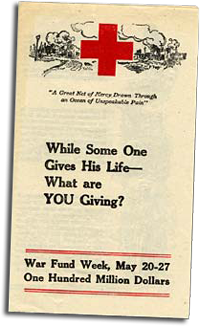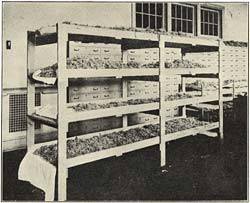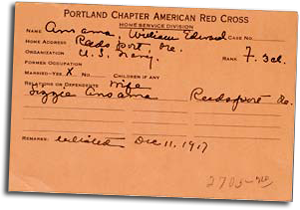 Red Cross brochure caption reads: "A great net of mercy drawn through an ocean of unspeakable pain." (OSA, Oregon Defense Council Records, Publications and Ephemera, Box 8, Folder 2) View brochure. (PDF)
Red Cross brochure caption reads: "A great net of mercy drawn through an ocean of unspeakable pain." (OSA, Oregon Defense Council Records, Publications and Ephemera, Box 8, Folder 2) View brochure. (PDF)
Patriotism and Obligation
Oregonians often worked extra hours on their farms or jobs to meet the added production demands of war. And they sacrificed in their homes by conserving wheat, sugar, and other war necessities. Yet, that was not enough in the eyes of 15 year old Harriet Rolfe of Sherman County: "A person who does not take any interest in the war or help carry it on, is just as much a slacker as the person who tries to shirk military duty." Thus it was that genuine patriotism mixed with obligation, conformity, and competition to power a remarkable range of activities in large and small communities across Oregon. While many groups and organizations participated and contributed to the war effort, none was more prominent than the Red Cross.
Organizing Red Cross Chapters
A large number of Red Cross chapters, branches, and auxiliaries formed in Oregon in the days and weeks after the declaration of war in April 1917. The Ontario chapter began then after members of the Ontario Woman's Club "decided to pigeon-hole their studies of South America and devote their energies to the making of surgical dressings." They contacted a Red Cross field representative for help in organizing and within a month the new chapter had over 360 members, including "three Japanese, one of whom pays annually $20.00 to the Japanese Red Cross Society."
Similarly, an April 16, 1917 meeting in Grants Pass yielded the organization of the Josephine County chapter of the Red Cross. Soon, numerous branches and school auxiliaries formed throughout the county. However, the largely mountainous terrain of the southern Oregon county made for a particularly challenging organizational situation:
Local Fund Raising Activities
Chapter members showed no lack of imagination in devising ways to raise money. Breakfasts, luncheons, dinners, bake sales, ice cream socials, plays, operas, dances, bazaars, raffles, rummage sales, carnivals, Vaudeville performances, lectures, recitals, and readings were among the ways that organizers collected money. Often the venue, food, and other considerations were donated by local businesses. Sometimes, several events were planned in conjunction to appeal to the broadest audience possible. This occurred in Grants Pass when "a two-day Bazaar was held by the ladies of the Red Cross...in the basement of the Court House, while in the evening, in the street in front of the Court House, a Carnival was held by the men.... At the same time, A Vaudeville performance was put on in the Court House building by Mrs. A.H. Gunnell. The net receipts of the two days were over fifteen hundred dollars."
Across the state in Nyssa, Red Cross volunteers held an auction with a particularly red, white, and blue flair. The patriotic event featured a coop of snow white chickens sporting red combs and blue wings. According to one chronicler, "most surprising of all, a couple of eggs were found in the coop striped with the national colors." The auction netted $1,500.
"Chapter Production"
Red Cross volunteers set up work rooms in many of the chapters, often in space donated by local businesses, churches, and schools. The bread and butter work was sewing an array of articles for both civilian and military use. These often fell into categories for statistical purposes. Descriptions such as hospital garments, surgical dressings, hospital supplies, soldiers supplies, knitted articles, and refugee garments headed the production lists submitted by chapters. Output was high by any standards. The Ontario chapter alone claimed delivery of 90,000 finished articles.
The Josephine County chapter, which included several men who worked as volunteer knitters, reserved "special mention" for one member. "'Grandma' Williams, eighty-four years of age, has knit 103 most beautiful sweaters. Her sweaters brought to the Chapter high praise from headquarters, and gave pleasure to the men who received them. One of our own boys had one on when wounded, and prized it so highly that it was a real grief when it had to [be] cut from him; so when this was known, another knit by her was sent to him." Grandma Williams received a medal for 2,400 hours of service to the Red Cross.
Meanwhile, in far off Malheur County along Oregon's border with Idaho, one reporter described the work in heroic terms:
In addition to the standard sewing and knitting work, some chapters were "particularly adapted" to more specialized contributions. For example, rainy Clatsop County excelled in the collection of sphagnum moss used in surgical dressings for the war. The Astoria chapter set aside a special room for the moss work. This included picking, cleaning, sorting, and drying the moss and then placing it between two sterilized gauze coverings. Every day about 15 women worked in the room producing thousands of dressing pads.
 Drying racks hold sphagnum moss ready for use in surgical dressing pads. (OSA, Oregon Defense Council Records, Publications and Ephemera, Box 9, Folder 1)
Drying racks hold sphagnum moss ready for use in surgical dressing pads. (OSA, Oregon Defense Council Records, Publications and Ephemera, Box 9, Folder 1)
Sometimes the numbers of volunteers in the work rooms needed to be augmented, either because of fatigue and drop outs or because of expanded production goals. The Clatsop County chapter went door to door attempting to enlist more needleworkers for the work rooms. While the results "were not commensurate with the amount of work devoted to this campaign," planners were at least satisfied "that the opportunity had been presented in person to every household in the city to enlist in the work of the Red Cross."
Canteens and Home Service
Red Cross chapters served, often on short notice, groups of soldiers and sailors passing through the area. Typically, the appropriate committee would spring into action as was the case when the Astoria chapter found out it was to provide lunch for 500 men on two hours notice. The volunteers quickly set up tables and chairs in the depot, drafted 50 high school girls to serve the men, and "requisitioned" food and supplies from local restaurants and bakeries. The lunch went off without a hitch. In Grants Pass, the local Red Cross chapter also learned on short notice that a large number of soldiers was passing through by train and that the chapter "was responsible for seeing that they were properly fed." The experience caused the chapter to form a "breakfast committee" that was ready to respond to similar needs in the future.
 Red Cross home service offices often kept records of the returning veterans they served. (OSA, Oregon Defense Council Records, Publications and Ephemera, Box 9, Folder 1)
Red Cross home service offices often kept records of the returning veterans they served. (OSA, Oregon Defense Council Records, Publications and Ephemera, Box 9, Folder 1)
"Home service" work by the Red Cross took many forms in Oregon. As more veterans returned home in later stages of the war and the postwar period, readjustment assistance became important. Many returning men went back to their old jobs, but for those without work, the Red Cross often served as an employment bureau. The Astoria chapter formed a "committee of After Care" for returning disabled soldiers and sailors. To better serve the veterans, one chapter member completed a six-week course on home service work at a Seattle institute.
Mrs. E.L. Tuttle, the executive secretary of the home service section of the Astoria chapter, also tried to reconnect local families with relatives overseas who had lost touch. The work was bittersweet as she found: " Some of these have been found alive and well, one son of an Astoria mother, however, was traced to his death-bed in a French Hospital after a mysterious silence of six months." Mrs. Tuttle's efforts were prodigious. She gave information to over 2,000 individuals. She cared for 25 disabled soldiers and sailors. And, she helped 199 men find work in the area.
Notes
(Oregon State Defense Council Records, State Historian's Correspondence, Box 1, Folder 37)